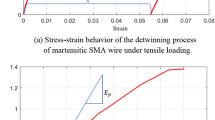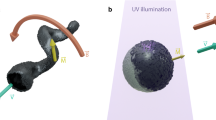Abstract
Inspired by bacterial flagella in nature, magnetic helical microswimmer is an ideal model to perform complex task in a low Reynolds number environments. Shape Memory Polymers (SMPs) with desirable properties are considered as one of the most preferred options for the development of small-scale robots. However, fabricating and programming strategies are still challenging. Here, we report an approach to fabricate helical microswimmers based on thermoplastic SMP (polylactic acid). Melt-spun polylactic acid fibers containing magnetic particles were enwound to form helical microstructures. Their shape recovery behaviors were programmed by annealing and pre-deformation. Three forms of helical microswimmers (constant-helix-angle conical helix, constant-pitch conical helix, and straight helix) with controlled morphological parameters were tailored. The obtained microswimmers showed 3D locomotion capability under rotating magnetic fields. The maximum swimming velocity of microswimmers was nearly six body lengths per second, and the near-wall swimming of conical helixes along their sharp end exhibited a smaller drift. Moreover, we demonstrated programmed shape-switching processes (spring-like contraction and elongation, coiling and uncoiling) and self-repairing of the microswimmers. As demonstrations of potential applications, tasks of mobile microstent, cargo delivery, and minimally invasive injection were carried out. The multifunctional shape-memory microswimmers have immense potential in a variety of applications.
Similar content being viewed by others
References
Sitti M, Ceylan H, Hu W Q, Giltinan J, Turan M, Yim S, Diller E. Biomedical applications of untethered mobile milli/microrobots. Proceedings of the IEEE, 2015, 103, 205–224.
Schmidt C K, Medina-Sanchez M, Edmondson R J, Schmidt O G. Engineering microrobots for targeted cancer therapies from a medical perspective. Nature Communications, 2020, 11, 5618.
Park J, Jin C, Lee S, Kim J Y, Choi H. Magnetically actuated degradable microrobots for actively controlled drug release and hyperthermia therapy. Advanced Healthcare Materials, 2019, 8, 1900213.
Kim D I, Lee H, Kwon S H, Sung Y J, Song W K, Park S. Bilayer hydrogel sheet-type intraocular microrobot for drug delivery and magnetic nanoparticles retrieval. Advanced Healthcare Materials, 2020, 9, 2000118.
Li J X, Esteban-Fernández de Ávila B, Gao W, Zhang L F, Wang J. Micro/nanorobots for biomedicine: Delivery, surgery, sensing, and detoxification. Science Robotics, 2017, 2, eaam6431.
Soto F, Wang J, Ahmed R, Demirci U. Medical micro/nanorobots in precision medicine. Advanced Science, 2020, 7, 2002203.
Nelson B J, Kaliakatsos I K, Abbott J J. Microrobots for minimally invasive medicine. Annual Review of Biomedical Engineering, 2010, 12, 55–85.
Diller E, Sitti M. Three-dimensional programmable assembly by untethered magnetic robotic micro-grippers. Advanced Functional Materials, 2014, 24, 4397–4404.
Kim H, Ali J, Cheang U K, Jeong J, Kim J S, Kim M J. Micro manipulation using magnetic microrobots. Journal of Bionic Engineering, 2016, 13, 515–524.
Zhang L, Peyer K E, Nelson B J. Artificial bacterial flagella for micromanipulation. Lab on a Chip, 2010, 10, 2203–2215.
Huang T Y, Qiu F, Tung H W, Chen X B, Nelson B J, Sakar M S. Generating mobile fluidic traps for selective three-dimensional transport of microobjects. Applied Physics Letters, 2014, 105, 114102.
Chen X Z, Jang B, Ahmed D, Hu C Z, De Marco C, Hoop M, Mushtaq F, Nelson B J, Pane S. Small-scale machines driven by external power sources. Advanced Materials, 2018, 30, 1705061.
Jang D, Jeong J, Song H, Chung S K. Targeted drug delivery technology using untethered microrobots: A review. Journal of Micromechanics and Microengineering, 2019, 29, 053002.
Peyer K E, Zhang L, Nelson B J. Bio-inspired magnetic swimming microrobots for biomedical applications. Nanoscale, 2013, 5, 1259–1272.
Go G, Nguyen V D, Jin Z, Park J O, Park S. A thermo-electromagnetically actuated microrobot for the targeted transport of therapeutic agents. International Journal of Control, Automation and Systems, 2018, 16, 1341–1354.
Li H, Go G, Ko S Y, Park J O, Park S. Magnetic actuated pH-responsive hydrogel-based soft micro-robot for targeted drug delivery. Smart Materials and Structures, 2016, 25, 027001.
Huang H W, Sakar M S, Petruska A J, Pane S, Nelson B J. Soft micromachines with programmable motility and morphology. Nature Communications, 2016, 7, 12263.
Yoshida K, Onoe H. Soft spiral-shaped microswimmers for autonomous swimming control by detecting surrounding environments. Advanced Intelligent Systems, 2020, 2, 2000095.
Leng J S, Lan X, Liu Y J, Du S Y. Shape-memory polymers and their composites: Stimulus methods and applications. Progress in Materials Science, 2011, 56, 1077–1135.
Lendlein A, Langer R. Biodegradable, elastic shape-memory polymers for potential biomedical applications. Science, 2002, 296, 1673–1676.
Medina-Sánchez M, Magdanz V, Guix M, Fomin V M, Schmidt O G. Swimming microrobots: Soft, reconfigurable, and smart. Advanced Functional Materials, 2018, 28, 1707228.
Carmela D M, Salvador P, Nelson B J. 4D printing and robotics. Science Robotics, 2018, 3, eaau0449.
Tsang A C H, Demir E, Ding Y, Pak O S. Roads to smart artificial microswimmers. Advanced Intelligent Systems, 2020, 2, 1900137.
Peyer K E, Tottori S, Qiu F, Zhang L, Nelson B J. Magnetic helical micromachines. Chemistry, 2013, 19, 28–38.
Qiu F, Nelson B J. Magnetic helical micro- and nanorobots: Toward their biomedical applications. Engineering, 2015, 1, 021–026.
Abbott J J, Peyer K E, Lagomarsino M C, Zhang L, Dong L X, Kaliakatsos I K, Nelson B J. How should microrobots swim?. The International Journal of Robotics Research, 2009, 28, 1434–1447.
Zhang L, Abbott J J, Dong L X, Kratochvil B E, Bell D, Nelson B J. Artificial bacterial flagella: Fabrication and magnetic control. Applied Physics Letters, 2009, 94, 064107.
Ghosh A, Fischer P. Controlled propulsion of artificial magnetic nanostructured propellers. Nano Letters, 2009, 9, 2243–2245.
Tottori S, Zhang L, Qiu F, Krawczyk K K, Franco-Obregon A, Nelson B J. Magnetic helical micromachines: Fabrication, controlled swimming, and cargo transport. Advanced Materials, 2012, 24, 811–816.
Zeeshan M A, Grisch R, Pellicer E, Sivaraman K M, Peyer K E, Sort J, Ozkale B, Sakar M S, Nelson B J, Pane S. Hybrid helical magnetic microrobots obtained by 3D template-assisted electrodeposition. Small, 2014, 10, 1284–1288.
Gao W, Feng X M, Pei A, Kane C R, Tam R, Hennessy C, Wang J. Bioinspired helical microswimmers based on vascular plants. Nano Letters, 2014, 14, 305–310.
Gong D, Cai J, Celi N, Feng L, Jiang Y G, Zhang D Y. Bio-inspired magnetic helical microswimmers made of nickel-plated spirulina with enhanced propulsion velocity. Journal of Magnetism and Magnetic Materials, 2018, 468, 148–154.
Yu Y R, Shang L R, Gao W, Zhao Z, Wang H, Zhao Y J. Microfluidic lithography of bioinspired helical micromotors. Angewandte Chemie International Edition, 2017, 56, 12127–12131.
Gagon D K, Denn M M. Computer simulation of steady polymer melt spinning. Polymer Engineering and Science, 2010, 21, 844–853.
Purcell E M. Life at low Reynolds number. American Journal of Physics, 1977, 45, 3–11.
da Silva D, Kaduri M, Poley M, Adir O, Krinsky N, Shainsky-Roitman J, Schroeder A. Biocompatibility, biodegradation and excretion of polylactic acid (PLA) in medical implants and theranostic systems. Chemical Engineering Journal, 2018, 340, 9–14.
Zhang X W, Lu Y. Centrifugal spinning: An alternative approach to fabricate nanofibers at high speed and low cost. Polymer Reviews, 2014, 54, 677–701.
Blachowicz T, Ehrmann A. Most recent developments in electrospun magnetic nanofibers: A review. Journal of Engineered Fibers and Fabrics, 2020, 15, 1–14.
Wang L F, Xu H C, Zhai W H, Huang B S, Rong W B. Design and characterization of magnetically actuated helical swimmers at submillimeter-scale. Journal of Bionic Engineering, 2017, 14, 26–33.
Xin C, Yang L, Li J W, Hu Y H, Qian D D, Fan S Y, Hu K, Cai Z, Wu H, Wang D W, Wu D, Chu J R. Conical hollow microhelices with superior swimming capabilities for targeted cargo delivery. Advanced Materials, 2019, 31, 1808226.
Peyer K E, Zhang L, Kratochvil B E, Nelson B J. Non-ideal swimming of artificial bacterial flagella near a surface. IEEE International Conference on Robotics and Automation, Anchorage, USA, 2010, 96–101.
Acknowledgment
This research was supported by the Foundation for Innovative Research Groups of the National Natural Science Foundation of China (No. 51521003), NSAF (No. U1930110), and the Self-Planned Task (No. SKLRS201909B) of State Key Laboratory of Robotics and System (HIT).
Author information
Authors and Affiliations
Corresponding authors
Supplementary file
Supplementary material, approximately 6.43 MB.
Supplementary material, approximately 8.92 MB.
Supplementary material, approximately 12.9 MB.
Supplementary material, approximately 23 MB.
Supplementary material, approximately 16.1 MB.
Rights and permissions
About this article
Cite this article
Zhao, F., Rong, W., Wang, L. et al. Magnetic Actuated Shape-memory Helical Microswimmers with Programmable Recovery Behaviors. J Bionic Eng 18, 799–811 (2021). https://doi.org/10.1007/s42235-021-0063-6
Published:
Issue Date:
DOI: https://doi.org/10.1007/s42235-021-0063-6




